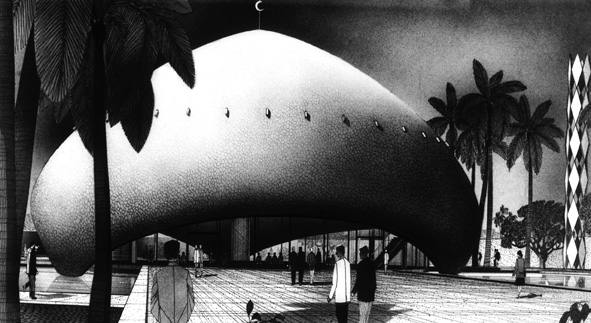Middle East architecture surprises in New York

If you're anywhere near New York, head to the Center for Architecture to see two surprising exhibitions on Middle Eastern architecture that opened last night.

One show demonstrates how Baghdad attracted the world's best architects, beginning in the 1950s. Alvar Aalto, Le Corbusier, Frank Lloyd Wright, Walter Gropius and Robert Venturi and Denise Scott Brown all had major commissions in Iraq, some resulting from competitions held by Saddam Hussein.
The show, conceived by Barcelona architect Pedro Azara and titled City of Mirages: Baghdad, 1952-1982, includes 16 intricate models revealing a modern Baghdad that might have been. For its U.S. debut, the installation covers two floors of the AIA New York Chapter's Center for Architecture in Greenwich Village. (Disclosure: Though I'm not a member, over the years I've consulted to the AIA New York Chapter, both pro bono and for pay.)
Contemporary trends in the Mideast
While City of Mirages details what might have been, an accompanying original show looks at 120 new buildings and projects in 20 Middle Eastern countries, mainly by U.S. firms.
The images -- though rather small -- are astounding, as much for their variety as for their truly contemporary expression. Assembled as part of CHANGE: Architecture and Engineering in the Middle East, 2000-Present, the photographs and renderings reflect the rapid urban growth and economic globalization in the area, including familiar images of supertall towers and man-made islands.
Though not explicitly addressed in the exhibition, the buildings raise questions about how to build sustainably in a region that lacks potable water and relies heavily on imported building materials.
But as Triple Pundit’s Leon Kaye blogs today, centuries of development in the Arabian Gulf region have created homes and workplaces that have been comfortable, durable and sustainable. Kaye lists the mass walls, "passive cooling features like wind towers" and gypsum, an abundant material in the region.
Big and green in Baghdad
While Kaye writes about Qatar, the same design rules hold true in Baghdad, Cairo, Dubai and Rabat. That's why an Astute Architect like this writer may look skeptically on works like Patrick Tighe's Villa Skhirat under construction in Morocco, or the 2010 Yas Marina Hotel in Abu Dhabi by Asymptote with Arup and Dewan Architects & Engineers. Gorgueous, yes. And perhaps the sheikh-sultans and high-flying businessmen who inhabit these glass-and-metal boxes can afford to cool them with their powerful air conditioners. But they are no model for long-term growth in the Middle East.
Better for the region's future are works like Beirut's USJ (Université Saint-Joseph) Campus de L’Innovation et du Sport by 109 Architectes, Rishad Khomarlou's neotraditional Cultural Center for Women in Bam, Iran, andPerkins+Will's ultra-modern Kuwait University College of Education, to be completed in 2014.
Even skyscrapers can be of this place and for this place. The Al Hamra Firdous Tower by Skidmore Owing & Merrill is not only Kuwait’s tallest building but undoubtedly the best idea ever for a desert tower. The stunningly asymmetrical concrete structure was inspired by traditional robes and regional lattice patterns -- SmartPlanet's own Sun Joo Kim covered it recently -- but more important it is a superbly regional environmental response.
In the 1950s, building designs by Wright and Le Corbusier used similar motifs and techniques, careful to employ natural means for supporting their city plans and Olympic parks, rather than envisaging a future of burning petroleum. That's another reason that City of Mirages is such a valuable collection of drawings, models and sketches.
Yet the maestros of Modernism upstairs, and the contemporary works downstairs at the Center for Architecture, were not assembled to spark talk of a green future on the Arabian Peninsula and Northern Africa. They are brought together to help document the surprising results of decades of building in those 20 nations.
Why surprising? First, for the diversity of design approaches. Second, most Americans haven't seen through our myopic media how modernization (and colonialism) are transforming the region's cities and buildings.
Third, there has emerged an indisputable and special brand of beauty that the Middle East can now share with the rest of the world.
This post was originally published on Smartplanet.com